Located in the south-eastern region of the United States and spanning 42,143 square miles, Tennessee has vast and diverse habitats. From mountains to rivers, there are plenty of places to live for many animals — including snakes.
There are 32 different species of snakes in the state, of which four are venomous. When we think of snakes, some of the first that come to mind are probably the brightly colored ones, but actually a lot of snakes are brown. Brown snakes can use their coloring to help them hide in plain sight as they easily blend in with their surroundings. So, let’s take a look at some of the brown snakes in Tennessee and discover where you’re likely to find them.
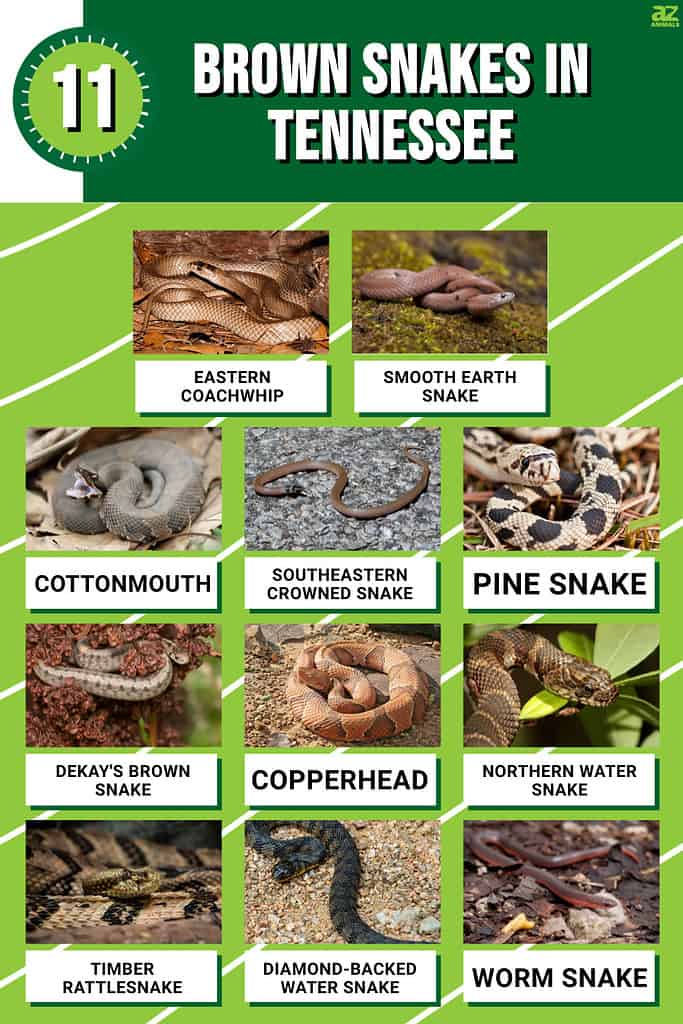
1. Eastern Coachwhip (Masticophis flagellum flagellum)
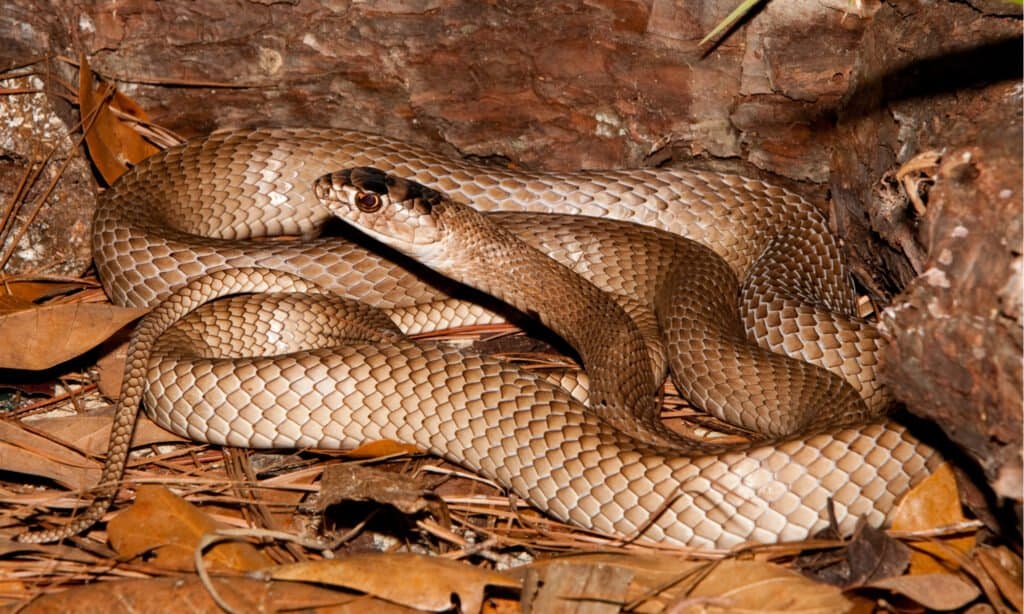
Eastern coachwhips are not venomous and eat their prey alive, swallowing them head first.
©Jay Ondreicka/Shutterstock.com
The first snake on our list is the eastern coachwhip, which is a subspecies of the coachwhip snake. These snakes are between 42 and 60 inches long with a slender body. They have a unique coloration as they are typically dark brown to black at the head, which gradually lightens to tan at the posterior end, giving the appearance of a braided coachwhip — hence their name. Eastern coachwhips are not venomous and eat their prey alive, swallowing them head first. They prefer to live in dry, open habitats such as scrubland and pine woods. However, they only occur in the southwestern corner of the state.
2. Smooth Earth Snake (Virginia valeriae)
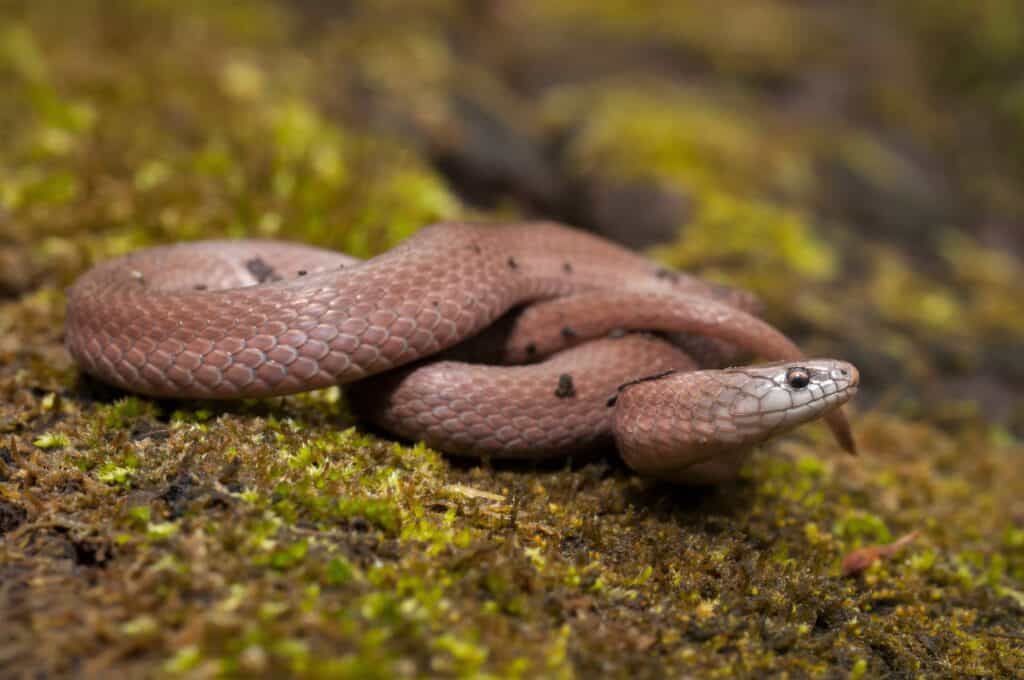
Smooth earth snakes are often mistaken for other small snakes such as the rough earth snake.
©Mike Wilhelm/Shutterstock.com
The smallest brown snake in Tennessee is the smooth earth snake, which is only 7 to 10 inches long. Smooth earth snakes have light to reddish brown bodies with smooth dorsal scales. They are easily confused with the rough earth snake (Virginia striatula), which also occurs in the state but has keeled scales. The smooth earth snake lives in forest habitats across the majority of the state. However, the rough earth snake only occurs in counties in the southwestern corner, particularly around Memphis.
3. Cottonmouth (Agkistrodon piscivorus)
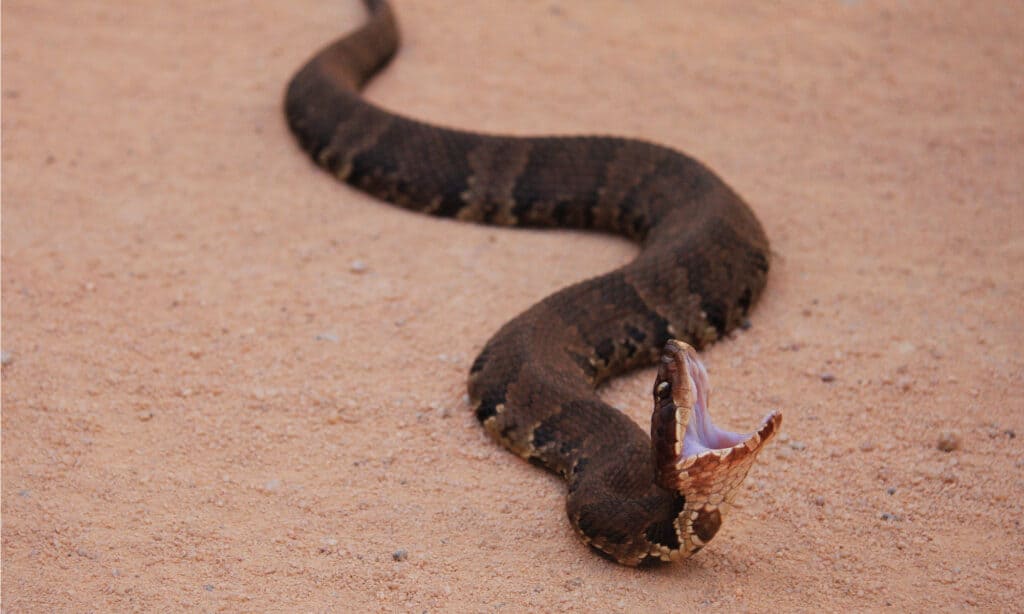
Cottonmouths are large
pit vipers
that can reach lengths of 30-43 inches.
©Nathan A Shepard/Shutterstock.com
The first venomous snake we’re going to mention is the semi-aquatic cottonmouth, which gets its name from the white lining inside its mouth that resembles cotton. Cottonmouths are large pit vipers that can reach lengths of 30-43 inches. They have dark brown bodies with darker brown — sometimes black — crossband markings. They can be found in and around any freshwater habitat but only occur in the western region of the state. Although cottonmouths are not the most deadly snake in the U.S. — accounting for around only 1% of all fatal snake bites — they possess cytotoxic venom that can cause extensive scarring. In some cases amputation of the affected limb is required.
4. Southeastern Crowned Snake (Tantilla coronata)
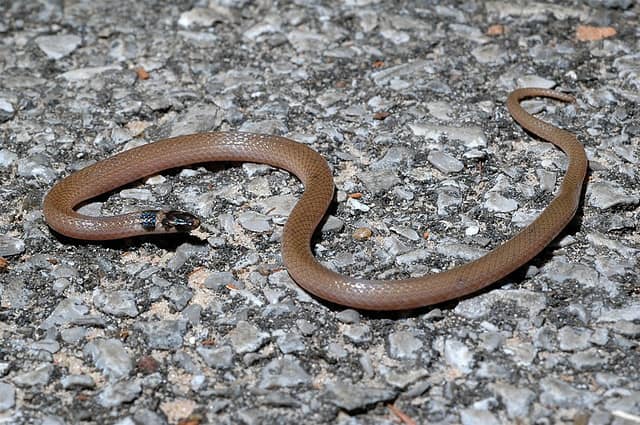
Southeastern crowned snakes live in the southern two-thirds of the state as well as in Stewart County.
© – License
Undoubtedly one of the smallest brown snakes in Tennessee is the southeastern crowned snake, which has a slender body and reaches only 8 to 10 inches long. They have brown bodies with a black head and neck. However, they also have a lighter band across the back of their head that divides it from the black neck band. Southeastern crowned snakes live in the southern two-thirds of the state as well as in Stewart County. They are secretive snakes and live in pine forests and hardwoods where there is plenty of sandy soil and leaf litter for them to burrow into.
5. Pine Snake (Pituophis melanoleucus)
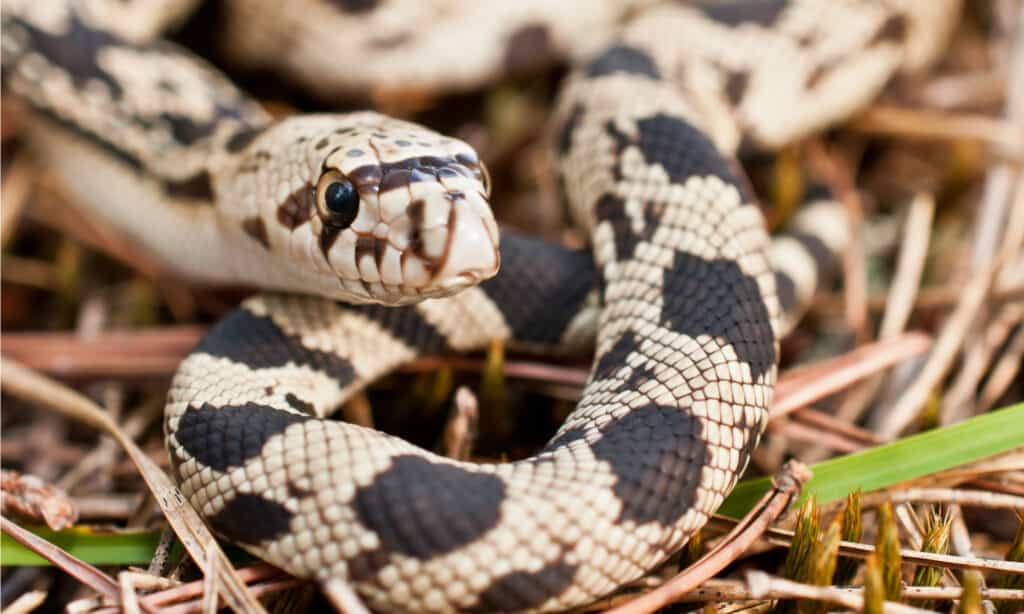
The Northern Pine Snake’s preferred habitats include pine forests, scrubland, and agricultural land.
©Jay Ondreicka/Shutterstock.com
At 48 to 66 inches long, pine snakes are some of the largest snakes in the state. They are powerful snakes with heavy bodies that are typically a yellowish color with dark brown blotches that lighten towards the tail. Only one subspecies — the northern pine snake — lives in Tennessee. where it occurs across the majority of the state, with the exception of the Central Basin, the western region, and the northern parts of the eastern region. Their preferred habitats include pine forests, scrubland, and agricultural land. Despite not being venomous, they can sometimes mimic venomous snakes by rearing up off the ground while hissing and vibrating their tail in the leaf litter.
6. Dekay’s Brownsnake (Storeria dekayi)
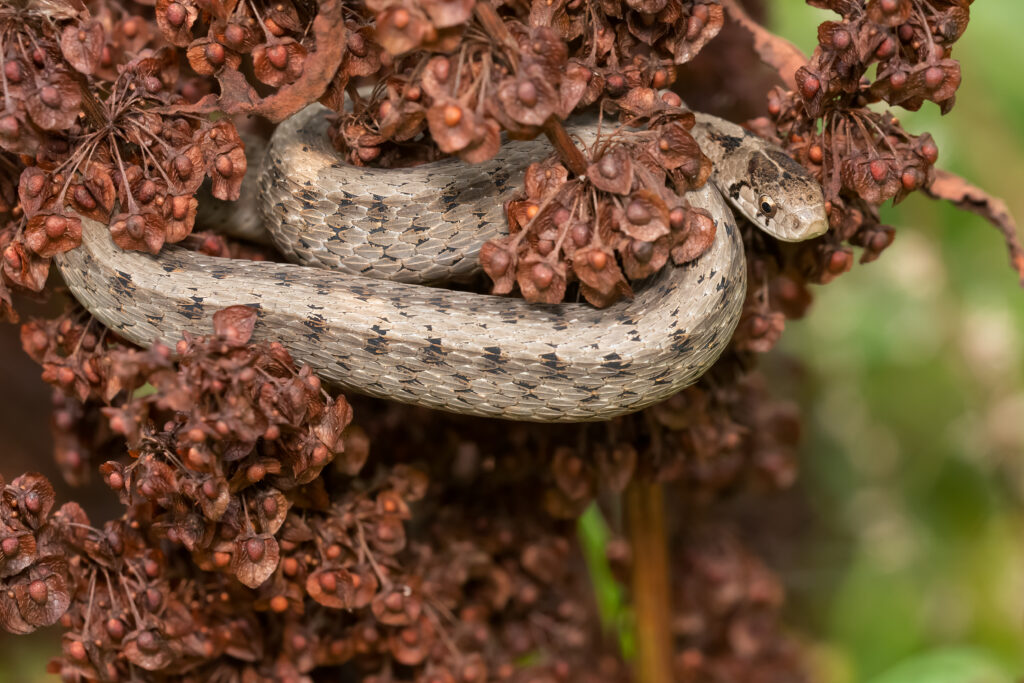
Given their small size they prey mostly on soft-bodies animals such as slugs and earthworms.
©Paul Reeves Photography/Shutterstock.com
One of the smallest and most secretive snakes in Tennessee is Dekay’s brownsnake, which only grows to lengths of 9 to 13 inches. They have slender brown bodies with two rows of darker spots along their back either side of a faint stripe. Although they are secretive and rarely seen, these snakes actually common across the majority of the state. They prefer moist habitats such as wetlands, floodplains, and moist pine and hardwood forests where there is plenty of cover for them to hide in. Given their small size they prey mostly on soft-bodies animals such as slugs and earthworms. They are not dangerous to humans but often squirm a lot and release a foul-smelling musk if they are handled.
7. Copperhead (Agkistrodon contortrix)
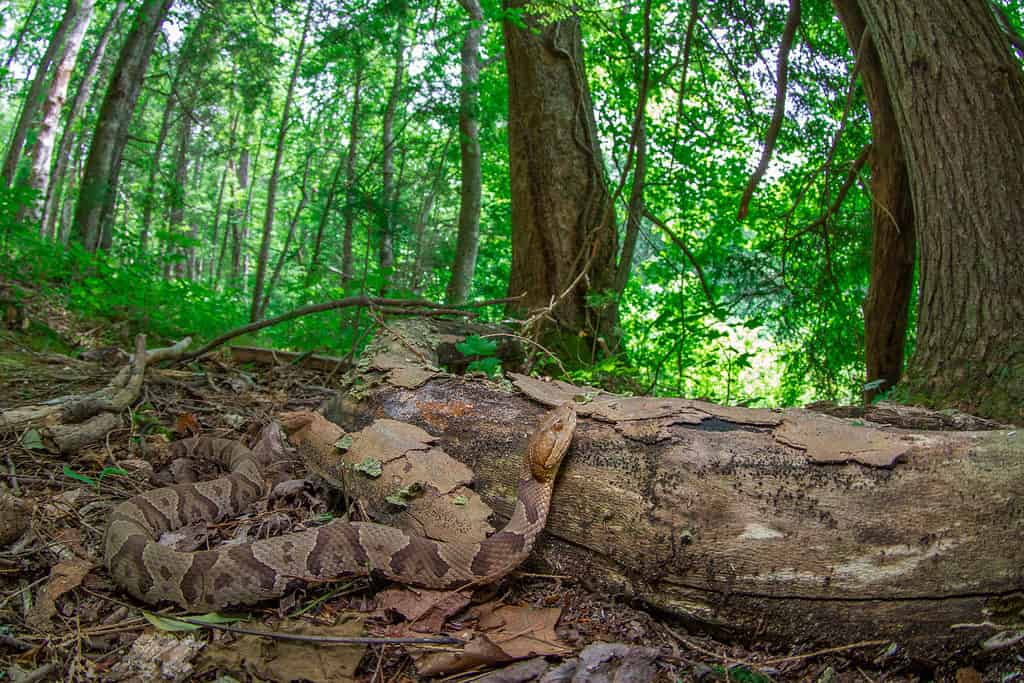
The
copperhead
‘s body is overlaid with dark brown crossbands that give it a distinctive “hourglass” pattern.
©JacobLoyacano/Shutterstock.com
Another venomous brown snake in Tennessee is the copperhead which occurs across the entire state. Copperheads are 24 to 36 inches long and have heavy, light brown bodies that are overlaid with dark brown crossbands that give a distinctive “hourglass” pattern. They mainly live in mixed forests and on wooded hillsides. However, they can sometimes be seen near urban environments. Copperheads prey on small mammals, rodents, and birds. Although they are venomous, their venom is relatively weak so does not usually pose much threat to healthy adults.
8. Northern Water Snake (Nerodia sipedon)
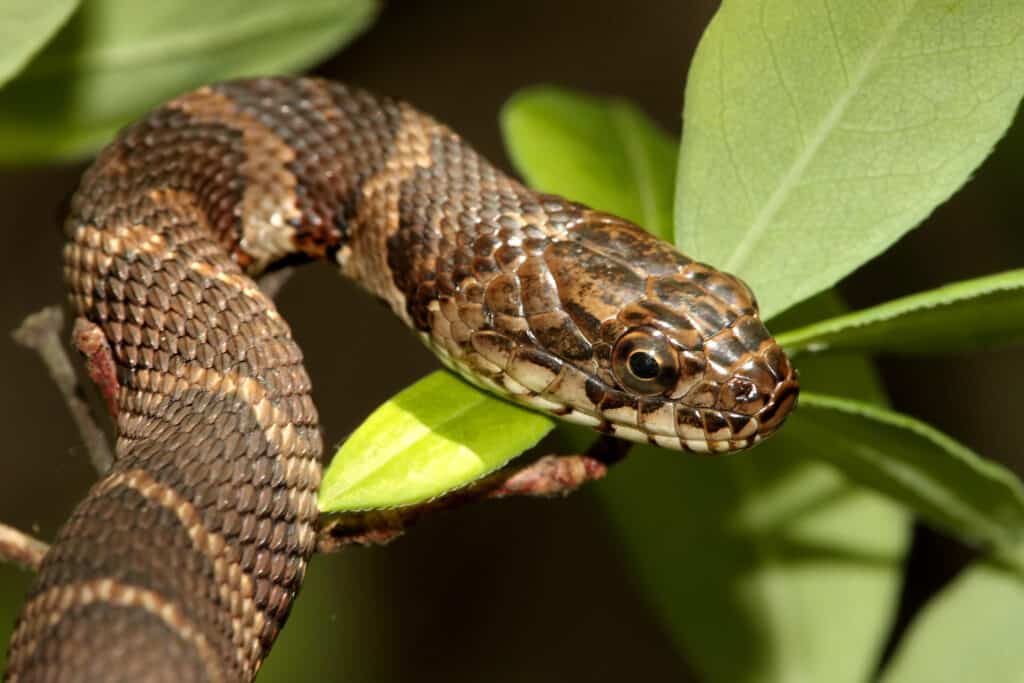
Northern water snakes occur across the entire state and can live in any
freshwater
habitat.
©Steve Byland/Shutterstock.com
Another aquatic snake is the northern water snake, which is often mistaken for the cottonmouth due to its similar appearance. Northern water snakes are approximately 56 inches long and have dark brown bodies which are overlaid with darker crossbands — sometimes giving them an almost black appearance. Northern water snakes occur across the entire state and can live in any freshwater habitat. Although they are not venomous they can be aggressive and will readily bite when they are disturbed. Any wounds inflicted by these snakes usually bleed a lot as their saliva contains an anti-coagulant.
9. Timber Rattlesnake (Crotalus horridus)
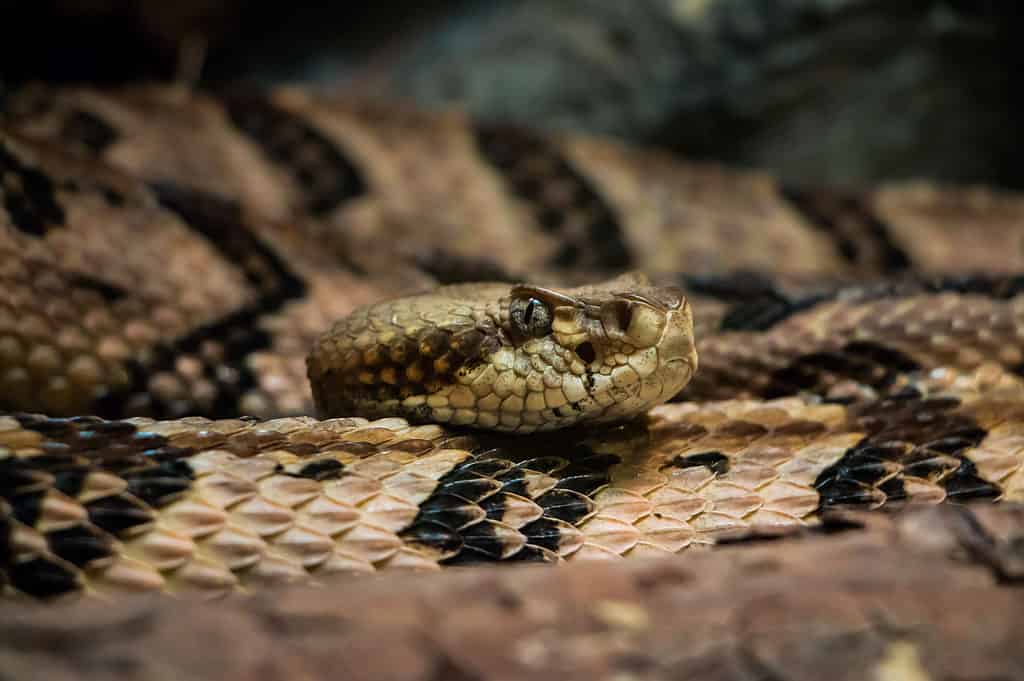
Timber
rattlesnakes
prefer dry, wooded hill places where they prey on a variety of small warm-blooded animals.
©Dennis Riabchenko/Shutterstock.com
Next up is the timber rattlesnake, which is the largest and most dangerous snake in the state. Timber rattlesnakes can reach 60 inches long and have large, thick bodies. They are typically brown and have dark brown to black crossband markings and keeled dorsal scales. Occurring statewide, timber rattlesnakes live in thick forests and on rocky hillsides. They can also often be found on rocky ledges, which are particularly favored by pregnant females and are known as “basking knolls.” Timber rattlesnakes prey on a variety of animals including birds, rodents, and lizards. They are highly venomous snakes and are classed as being one of the most dangerous in North America due to their large fangs and the high venom yield.
10. Diamond-Backed Water Snake (Nerodia rhombifer)
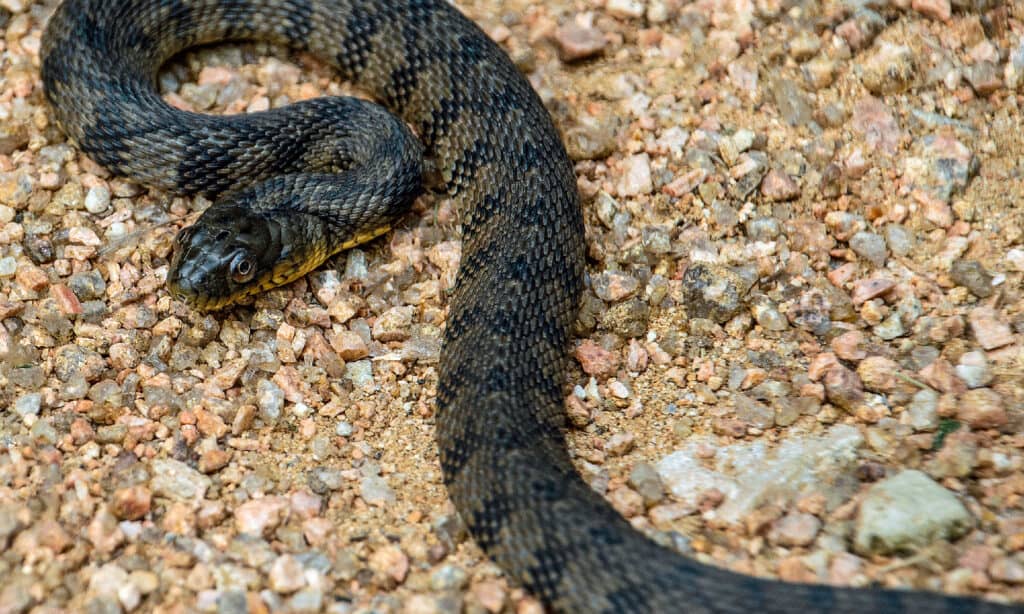
Diamond-backed water snakes are found in Tennessee in counties near the Mississippi River and in Reelfoot Lake.
©iStock.com/williamhc
The next brown snake in Tennessee is the diamond-backed water snake. This snake has a brown body with a darker chain-like pattern along its back, creating diamond-shaped markings. Diamond-backed water snakes are 30 to 48 inches long and have a thick, heavy body. They live in a variety of freshwater habitats but tend to prefer slow-moving bodies of water such as swamps, sloughs, and ox-bow lakes. In Tennessee they can only be found in the counties bordering the Mississippi River and in Reelfoot Lake. Although they are not venomous they will frequently hiss and flatten their neck in an attempt to ward off predators. However, they often resort to biting and are sometimes misidentified as the venomous cottonmouth.
11. Worm Snake (Carphophis amoenus)
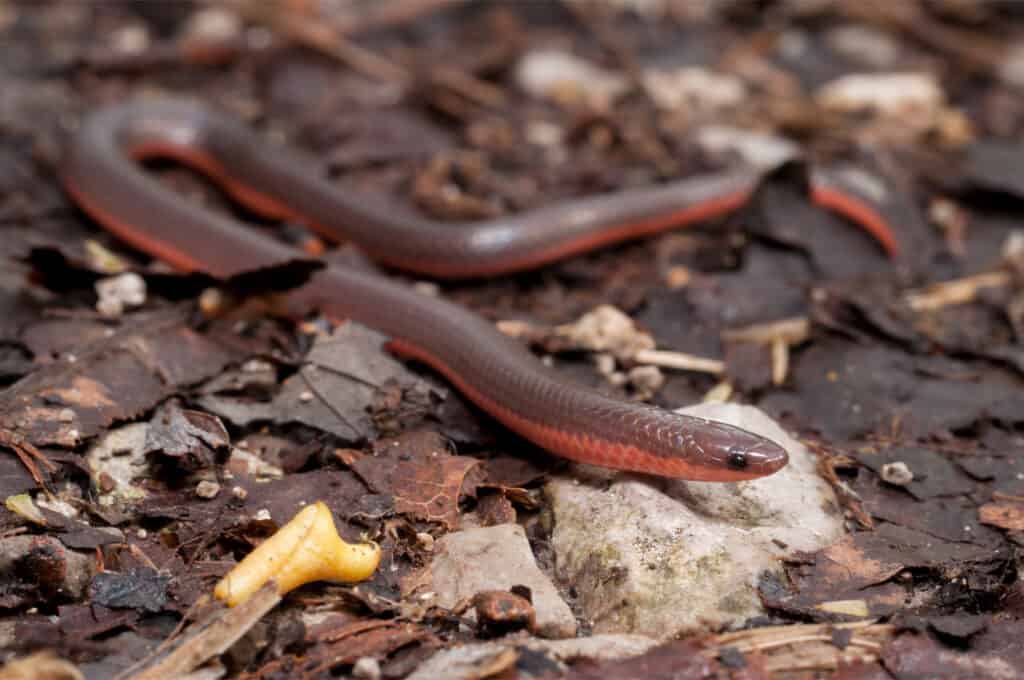
Worm snakes primarily live in hardwood forests where they can hide away underneath the leaf litter.
©Mike Wilhelm/Shutterstock.com
The final snake on the list is another small snake — the worm snake. Worm snakes have a maximum length of 13 inches and have glossy brown bodies. As they are so small they only prey on small animals, with earthworms being their preferred diet. Worm snakes primarily live in hardwood forests where they can burrow underneath logs and rocks or hide away underneath the leaf litter. There are two subspecies that occur in Tennessee: the eastern and midwestern worm snakes. Eastern worm snakes live in the Unaka mountains and the Great Valley region, while the midwestern worm snake lives across the rest of the state.
Summary of 11 Brown Snakes in Tennessee
Here’s a recap of the 11 snakes we looked at that have brown coloring and can be found in Tennessee.
| Number | Snake | Scientific Name | Length | Range in Tennessee |
|---|---|---|---|---|
| 1 | Eastern Coachwhip | Masticophis flagellum flagellum | 42-60 inches | Southwestern corner |
| 2 | Smooth Earth Snake | Virginia valeriae | 7-10 inches | Counties in the southwestern corner, especially around Memphis |
| 3 | Cottonmouth | Agkistrodon piscivorus | 30-43 inches | Western region |
| 4 | Southeastern Crowned Snake | Tantilla coronata | 8-10 inches | Southern two-thirds of the state as well as in Stewart County |
| 5 | Pine Snake | Pituophis melanoleucus | 48-66 inches | Majority of the state, except for the Central Basin, western region, and northeastern region |
| 6 | Dekay’s Brownsnake | Storeria dekayi | 9-13 inches | Common across most of the state |
| 7 | Copperhead | Agkistrodon contortrix | 24-36 inches | Statewide |
| 8 | Northern Water Snake | Nerodia sipedon | 56 inches | Statewide |
| 9 | Timber Rattlesnake | Crotalus horridus | 60 inches | Statewide |
| 10 | Diamond-Backed Water Snake | Nerodia rhombifer | 30-48 inches | Counties bordering the Mississippi River and in Reelfoot Lake |
| 11 | Worm Snake | Carphophis amoenus | 13 inches | Eastern worm snake: Unaka mountains and the Great Valley region; mid-western worm snake: across the rest of the state |
The photo featured at the top of this post is © Paul Reeves Photography/Shutterstock.com
Thank you for reading! Have some feedback for us? Contact the AZ Animals editorial team.






